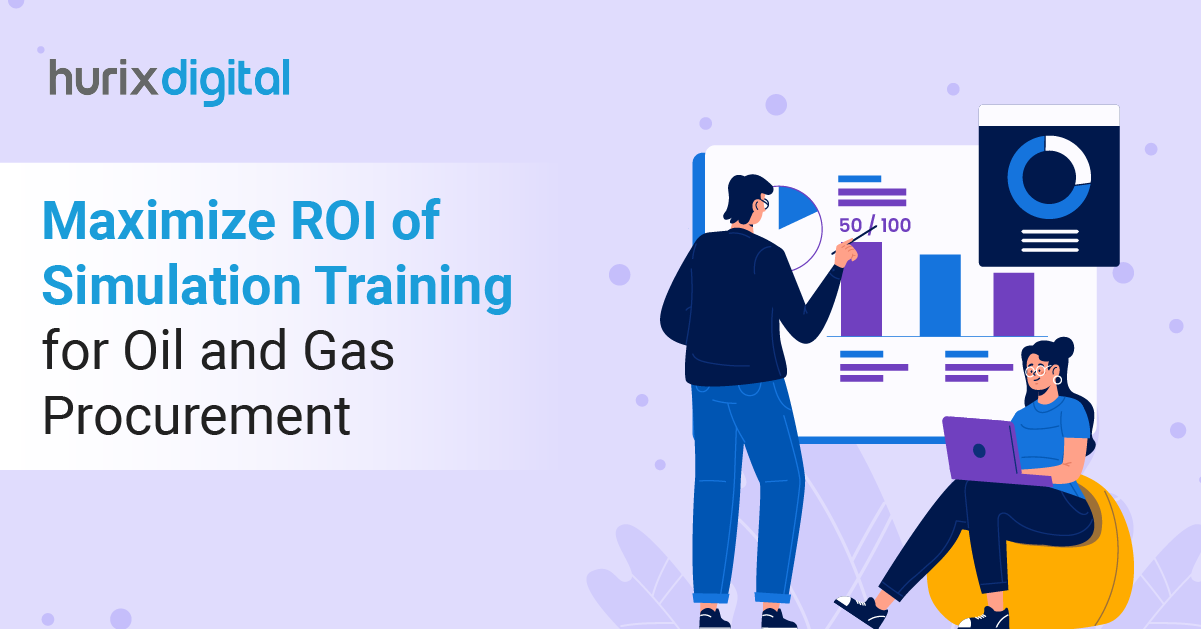
Maximize ROI of Simulation Training for Oil and Gas Procurement
Summarize with:
The oil and gas industry is known for its high-risk environment. As workers go through complex processes of transportation and hazardous conditions, their safety is paramount. More importantly, the procurement professionals and specialists too need essential training and development to get accustomed to the norms of the oil and gas industry. It is significant for industry leaders to address such requirements effectively.
One of the best ways to counter such needs is to provide simulation training to equip workers to deal with challenging situations. Simulation training has become an indispensable tool today as it is integrated with advanced technology. It has become easier for content creators to mimic real-world scenarios and create a realistic environment.
According to a report, companies that implemented process optimization training saw a 20% reduction in procurement cycle times and a 15% decrease in overall costs. This kind of simulation training empowers procurement experts to refine their emergency response skills and knowledge.
Let’s delve in to learn how to calculate the ROI of simulation training and about advanced procurement training methods!
Table of Contents:
- Importance of ROI of Simulation Training
- The Evolution of Simulation-Based Training in the Oil and Gas Industry
- ROI of Simulation-Based Training in Oil and Gas Industry— Long-Term and Consistent Investment
- Best Simulation Training for Procurement Professionals
- How to Evaluate the Best Simulation Training Programs for Workers in the Oil and Gas Industry
- Benefits of Simulation Training for Procurement Professionals
- Best Practices for Simulation Training in Oil and Gas
- Conclusion
Importance of ROI of Simulation Training
Identifying and calculating the ROI of simulation training helps industry leaders and the director of procurement to make informed decisions about where to allocate training budgets. ROI tells you about the effectiveness of training programs and helps in justifying training investments to stakeholders.
The Evolution of Simulation-Based Training in the Oil and Gas Industry
Traditional on-the-job training in the oil and gas industry was not error-proof and led to certain risks. With the advancement of technology, simulation-based training came into the picture, which helped industries recreate high-risk scenarios in a safe environment. This allows the workforce to test their skills and practice responses to incidents without real-world danger.
Simulation training also helps leaders deliver real-time feedback based on immediate assessments. This helps professionals understand their actions and refine their approaches.
Training procurement teams in oil and gas can be personalized according to specific operations or facilities, which means workers can develop skills according to their roles.
Also Read: Designing Personalized Learning Pathways for Your Workforce
ROI of Simulation-Based Training in Oil and Gas Industry— Long-Term and Consistent Investment
The initial costs of simulation training may seem high as it includes certifications, equipment, and software. But over time, industry leaders realize how it properly train to make the right decisions in high-pressure situations.
This benefit reduces long-term costs and minimizes the risk of accidents and mistakes. The importance of assessing the ROI of simulation training in the oil and gas industry continues to increase as it ensures operational effectiveness.
Calculating ROI in Simulation Training
Here are key steps that can help you calculate ROI
Step 1: Identify direct and indirect costs.
Step 2: Measure benefits.
Benefits can be tangible (cost savings, production outputs, etc.) or intangible (employee engagement, improved decision-making, etc.).
Step 3: Calculate Net Benefits using the formula:
Net Benefits = Total Benefits – Total Costs.
Step 4: Calculate ROI using the formula:
ROI (%) = (Net Benefits / Total Costs) x 100.
ROI in simulation training offers data to support investment in training programs. It helps leaders identify areas where training has led to significant process improvements. It further encourages continuous improvement in procurement practices and shows commitment to employee development.
Best Simulation Training for Procurement Professionals
Some of the top simulation programs for workers in the oil and gas industry are:
1. Training on Supplier Relationship Management
Workers engage in simulations of supplier negotiations. These modules can include interactive elements such as role-playing exercises which help trainees understand their areas for improvement.
2. Training on Advanced Safety and Operational Protocols
The oil and gas industry follows stringent standards and safety requirements. Procurement professionals must adapt to these changes and learn about the complexities of updated regulations and safety mandates. Training procurement teams in oil and gas using such modules can recreate real-world scenarios to instill best practices.
3. Training on Digital Transformation
Simulation-based learning helps trainees enhance technical skills and manage complex machinery and software. These modules can be built on drilling techniques to emergency response drills.
4. Training in Leadership and Management Development
These training modules present challenging scenarios that test the critical thinking and adaptability of workers. The simulation presents complex situations, which helps leaders gain the practice and knowledge to guide their operations. This simulation helps them understand uncertainties, and ways to leverage industry insights.
5. Training on Risk Management
Simulated modules are equipped with various kinds of risk scenarios, such as supply chain disruptions, market volatility, and geopolitical risks. Trainees develop the skills to identify risks and implement mitigation strategies.
6. Training on Procurement Process Optimization
This training covers methods for streamlining procurement processes and reducing inefficiencies. It shows workers how to use procurement technologies and measure performance. Additionally, it encourages the use of data analytics to make informed decisions.
How to Evaluate the Best Simulation Training Programs for Workers in the Oil and Gas Industry
Here are some strategies to choose the best simulation training for procurement professionals in the oil and gas industry:
- The program should be according to the specific challenges and requirements of the oil and gas industry.
- The modules should include high levels of interactivity. This is to ensure that trainees remain engaged and can apply their learning in practical scenarios.
- Look out for realistic simulations that can help trainees experience actual challenges they may face in their roles.
- Choose platforms that offer continuous feedback and assessment mechanisms. These are essential for tracking progress and areas needing improvement.
- The program should offer flexible learning options, including online and in-person sessions. This will help industry leaders accommodate different learning styles and schedules.
- Choose programs that allow you to customize training modules and offer recognized certifications. Further, ensure that you have access to experienced instructors and post-training support and resources to help trainees continue their learning journey.
Benefits of Simulation Training for Procurement Professionals
According to a report by Training Industry, 72% of companies using simulation-based training have shown enhanced performance, and 68% have improved worker productivity.
That said, here are the various benefits of simulation training:
1. Critical Thinking and Problem-Solving
Simulation training places procurement professionals in realistic scenarios that require immediate decision-making and problem-solving. This hands-on approach helps develop critical thinking skills by allowing participants to make strategic decisions.
2. Negotiation Skills
Simulation training often includes role-playing exercises where trainees learn how to negotiate. These exercises can be simple transactions or multi-party negotiations. For instance, trainees might be required to negotiate a long-term contract with a key supplier.
3. Risk Management
Simulation training can include scenarios that allow procurement professionals to come across various risks. It further helps procurement professionals identify inefficiencies in their processes and develop strategies to manage operations.
4. Supplier Management
Simulation training helps professionals develop better supplier management skills. This leads to more effective and strategic supplier partnerships.
5. Technology Integration
Simulation training can include modules on the effective use of procurement technologies. It can include e-procurement systems, data analytics, and automation tools, which can help your workforce streamline purchasing processes and improve transparency.
Further, it helps industry leaders identify and implement cost-saving strategies. Research says that standardizing the procurement process can lead to an average cost reduction of 10% to 15% in an organization’s procurement activities.
Best Practices for Simulation Training in Oil and Gas
Here are some best practices for improving simulation training programs.
1. Personalization in Content Creation
Oil and gas procurement involves unique challenges, such as dealing with volatile commodity prices, complex supply chains, and high-risk environments. Customizing scenarios ensures that the training is relevant and practical. Leaders must use real-world data and case studies, along with interactions with various stakeholders, in their simulation training modules.
2. Role-Based Training
Different roles within the procurement function may require different skills and knowledge. It is imperative to customize training according to specific roles. You must offer specialized modules along with feedback opportunities that can help in improving the training program.
3. Performance Metrics
Use relevant KPIs to assess areas for improvement. Some of the main KPIs are cost savings, process efficiency, risk mitigation, and employee satisfaction. Regularly monitor these KPIs to assess the impact of the training.
4. Advanced Procurement Training Methods
Advanced simulation technologies provide more realistic and immersive training experiences. You can incorporate AR or VR simulations and AI and machine learning algorithms.
Further, data analytics helps in measuring the effectiveness of training and identifying areas for improvement. Gamification makes training more engaging for trainees. It is important to identify trends in the data to understand common challenges and areas where trainees struggle.
5. Team-Based Learning
Collaborative training helps learn from each other’s experiences and perspectives. Encourage trainees to share their insights and experiences. Implement group projects that simulate real-world procurement challenges and require collective problem-solving.
Read EXCLUSIVE: The Rise of VR and AR in Enterprise Learning
Conclusion
Upskilling procurement professionals in the Oil and Gas industry using simulation training has become imperative today. Professionals must adapt, evolve, and master new skills using interactive learning modules designed for this sector.
Leaders must make sure that simulation training modules empower professionals to stay ahead of the curve. It is recommended to invest in advanced procurement training methods for efficient procurement processes and cost savings
Get in touch with the professionals at Hurix Digital and make the most of customized training content, interactive methods, and continuous learning for procurement professionals and the oil and gas industry.
Connect with us today to get started!
Summarize with:

 A Space for Thoughtful
A Space for Thoughtful 



